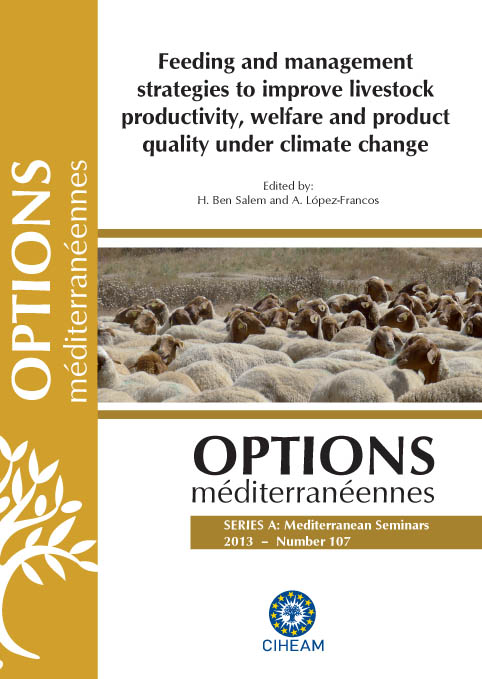| Article précédent | p. 63-68 | Article suivant |
Nutritive evaluation of foliage from some Acacia trees characteristic of Algerian arid and semi-arid areas
Chemical composition and digestibility of foliage from five Acacia species (Acacia nilotica, Acacia horrida, Acacia saligna, Acacia albida and Albizia julibrissin) from arid and semi-arid areas of Algeria were evaluated. Feed components of proximate analysis were determined, whereas phenolic and tannin compounds were analysed by colorimetric procedures and their activity tested using a biological assay. Digestibility was assessed by conventional gravimetric in vitro and in situ methods, and rumen fermentation kinetics were measured using the in vitro gas production technique. Results showed that all browses contained high levels of CP (157-252 g/kg DM). The content of neutral detergent fiber was highest in A. horrida (551 g/kg DM) and lowest in A. nilotica (290 g/kg DM). The content of lignin was highest in A. saligna (147 g/kg DM). The tannin concentrations varied considerably between species, but in general the plants investigated in this study had high tannin contents. A. nilotica had the highest levels of TP and TET (213 and 205 g/kg DM, respectively). The TCT content ranged from 60 g/kg DM in A. albida to 726 g/ kg DM in A. nilotica. The leguminous fodder tree A. julibrissin shows high protein content and its foliage is highly digestible probably due to its low tannin content. It was concluded that foliage from Acacia species is a protein-rich fodder for ruminants, although the high lignin and tannin content of some species represents an important constraint that could limit digestive utilization in the gastro-intestinal tract of these species.
La composition chimique et la digestibilité du feuillage de cinq espèces d’Acacia (Acacia nilotica, Acacia horrida, Acacia saligna, Faidherbia albida et Albizia julibrissin), récoltées de zones arides et semiarides d’Algérie, sont étudiées. Leurs composants organiques majeurs sont déterminés, tandis que leurs teneurs en polyphénols et tannins sont analysées par colorimétrie. Leur digestibilité est évaluée par les méthodes gravimétriques in vitro et in situ. La technique dite in vitro gas production est utilisée pour le suivi cinétique des fermentations ruminales. Les échantillons étudiés montrent donc des taux élevés en protéines (157-252 g/kg MS), le contenu le plus élevé en FND étant noté chez A. horrida (551 g/kg MS) et le plus faible chez A. nilotica (290 g/kg MS). La valeur la plus élevée en lignine est enregistrée chez A. saligna (147 g/kg MS). Les concentrations en tannins varient considérablement entre les différentes espèces étudiées mais, de manière générale, elles sont élevées. Les taux les plus hauts en polyphénols totaux et en tannins totaux extractibles sont enregistrés chez A. nilotica (213 et 205 g/kg MS, respectivement). Pour les tannins condensés totaux, les valeurs varient de 60 g/kg MS chez F. albida à 726 g/kg MS chez A. nilotica. La légumineuse A. julibrissin présente un taux protéique élevé et son feuillage est hautement digestible, probablement en raison de son faible contenu en tannins. En conclusion, les résultats obtenus montrent que le feuillage issu des espèces d’Acacia est un fourrage globalement riche en protéines, alors que des taux élevés en lignine et tannins sont observés, ce qui peut représenter un facteur limitant de leur assimilation dans le tractus gastro-intestinal.
- [ Afficher ]
- [ Télécharger ]
- [ Exporter la citation ]
Vous pouvez télécharger la citation au format :
- [ Imprimer ]
-
Mots-clés
ACACIA SALIGNA, FEUILLES, FOURRAGE, TANNIN, VALEUR NUTRITIVE, ZONE ARIDE, ZONE SEMI-ARIDECiter cet article
Boufennara S., Bouazza L., Bodas R., Bousseboua H., López S. Nutritive evaluation of foliage from some Acacia trees characteristic of Algerian arid and semi-arid areas. In : Ben Salem H. (ed.), López-Francos A. (ed.). Feeding and management strategies to improve livestock productivity, welfare and product quality under climate change. Zaragoza : CIHEAM / INRAT / OEP / IRESA / FAO, 2013. p. 63-68. (Options Méditerranéennes : Série A. Séminaires Méditerranéens; n. 107). 14. International Seminar of the Sub-Network on Nutrition of the FAO-CIHEAM Inter-Regional Cooperative Research and Development Network on Sheep and Goats, 2012/06/15-17, Hammamet (Tunisia). http://om.ciheam.org/om/pdf/a107/00007012.pdf



